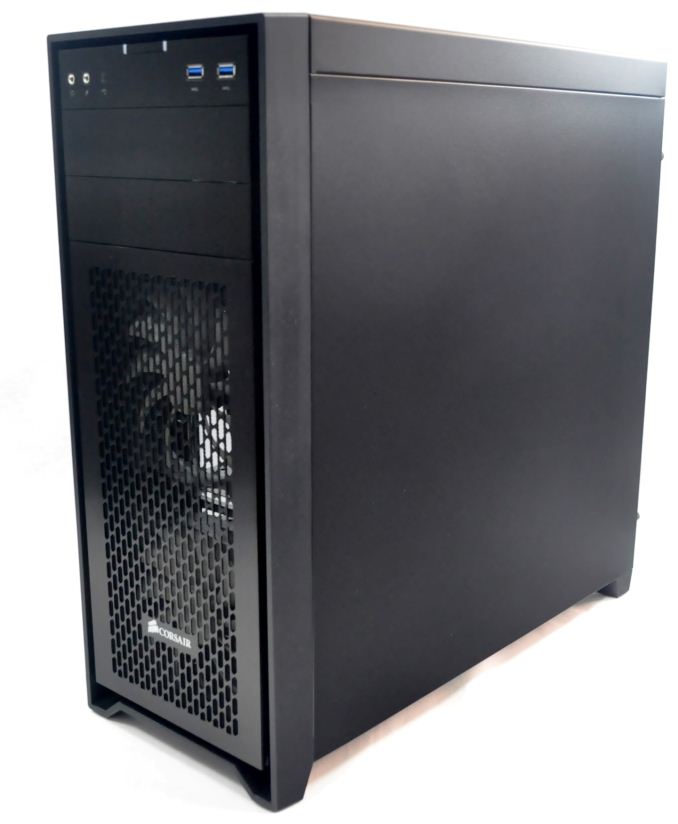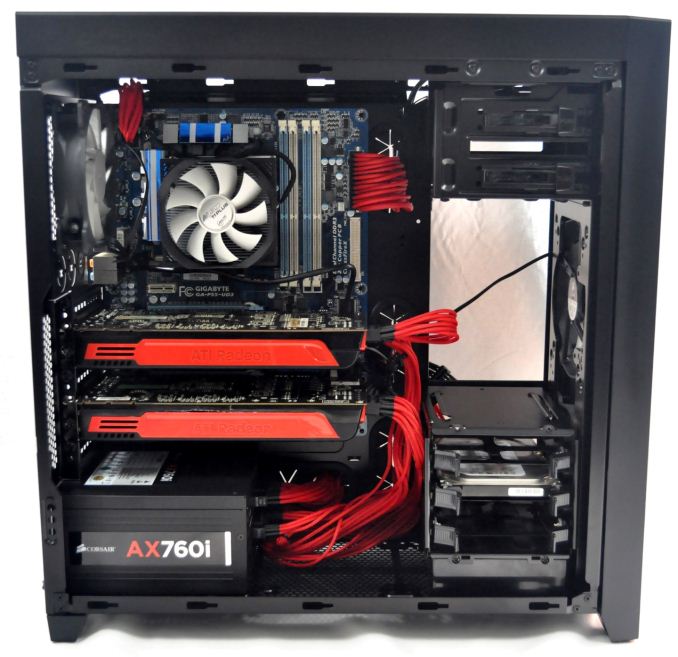Corsair Obsidian 450D Case Review
by E. Fylladitakis on April 4, 2014 6:00 AM EST- Posted in
- Cases/Cooling/PSUs
- Corsair
- mid-tower
- Case
Final Words
With the Obsidian 450D, Corsair attempted to fill the gap between the Micro-ATX 350D and the very large 750D of the same series with a mid-tower case of normal proportions. Yes, they already have half a dozen mid-tower cases available, such as the Graphite 230T and the Carbide 300R, but only the 650D / 550D are part of the Obsidian series and they have been engineered with entirely different target groups in mind. The Obsidian 450D is a normal sized mid-tower case designed to deliver flexibility and cooling for a reasonable retail price. Considering the variety of cooling options that may be applied and the additional flexibility that the removable drive cage offers, the Obsidian 450D does very well in terms of versatility, within the boundaries of a mid-tower design of course.
The thermal performance of the Obsidian 450D definitely is to be reckoned. Even with the slow-spinning stock fans, the heavily perforated chassis of the Obsidian 450D allows heat to escape towards virtually all directions if required. As such, the thermal performance of the Obsidian 450D is unusually high for a mid-tower ATX design. On the other hand, these many openings have the exact opposite effect when it comes to noise suppression; they do nothing to stop noise from exiting the chassis.
The stock cooling of the Obsidian 450D is very good in terms of acoustics performance, with the fans being only slightly audible even while running at maximum speed; however, although the noise figures are very low for a case with so many openings, even with the fans running at maximum speed, the noise of everything installed inside the Obsidian 450D (e.g. GPUs, CPU coolers, etc.) will not be damped in the slightest. Corsair obviously did not design Obsidian 450D with minimal noise operation in mind; it wouldn't make much sense to do so either, as they already had the Obsidian 550D available for that purpose.
In terms of design, the Obsidian series consists of Corsair's most serious and elegant products. They have not been created so as to stand out via an aggressive appearance or strong lighting; the Obsidian series cases lure the attention of spectators through their clean, refined design. The post-minimalistic design of the 450D is undoubtedly a perfect match for the Obsidian series. Uniqueness however is an entirely different story; the Obsidian 450D is essentially a larger 350D or smaller 750D, as all three of these cases share the same design. Even the cubic 250D and the massive 900D share a similar core design, with the distinguishable dissimilarities being due to their much different shape. If the 450D had no perforated front intake cover, it could be easily mistaken for a 350D, even though the latter is significantly shorter.
The MSRP of $119 is reasonable for an Obsidian series case, especially considering that the similarly sized 650D retails for nearly twice the price. However, there are multitudes of similarly sized and less expensive products available, some of which offer the Obsidian 450D strong competition. Even Corsair's own products, such as the Carbide 500R and 300R, are possible opponents for the Obsidian 450D, as they too offer good cooling options and versatility. We however believe that the strongest feature of the Obsidian 450D is its graceful, clean appearance, which will surely attract a significant number of consumers all by itself.
In summary, the Obsidian 450D delivers great cooling performance and a clean aesthetic at a moderately high price. Those who have eyed the Obsidian 350D in the past and wanted something a bit larger (but not as large as the 650D) will be pleased with what it offers. Corsair continues to make cases that are easy to work with and have all the necessary features, and the 450D is no exception. While it's not the best fit for a low-noise solution, enthusiasts and gamers will have plenty to work with.












36 Comments
View All Comments
Communism - Friday, April 4, 2014 - link
Please use comparison tables/graphs of some sort (to compare them to the other cases you have reviewed), as these results are basically meaningless without them.Maybe do the tables/graphs comparing the temperature of each component at the longest time measurement the is common between each of the cases tested.
Communism - Friday, April 4, 2014 - link
Maybe start a "Case 2014" in "Bench"http://www.anandtech.com/bench/Cases/742
And put a link to it in each section of your results corresponding to the "Bench" entry you are talking about.
UltraWide - Friday, April 4, 2014 - link
This is actually a great idea!E.Fyll - Friday, April 4, 2014 - link
We just have too few samples right now. A database will be created once there are at least a few reviews of each type of case available.just4U - Friday, April 4, 2014 - link
Is that your new test PSU for builds, or is it just going to be used for Corsair stuff? It's a good power supply for getting a nice clean wiring job and makes things relatively easy for setup. btw, What extensions are those you are using? The red thingies.. is that a accessory from Corsair?poisonsnak - Saturday, April 5, 2014 - link
Corsair makes individually sleeved cables. I couldn't get them to come up on corsair.com for some reason but I found a blue kit on NCIX http://products.ncix.com/detail/corsair-profession...Black Obsidian - Friday, April 4, 2014 - link
It almost seems as though the 450D is the successor to the 650D. It basically trades the "old Corsair" design (fewer, larger fans, limited radiator support, full complement of drive cages) for the "new Corsair" design (lots of radiator support, and thus almost necessarily more, smaller fans, additional purchase to reach full complement of drive cages but 2.5" mounts behind the motherboard to compensate), shedding the fan controller in the process.And yet the point about the 650D costing nearly twice as much is a good one. Even as someone who owns and quite enjoys a 650D, I can't think of a good reason why that is. Sure, the extra drive cage and fan controller are handy, but not $100+ handy.
Also, E, although I know we don't (and are seemingly unlikely to ever) see eye-to-eye on the usefulness of your thermal testing method, I just wanted to say that I appreciate how you've been adapting your reviews to take into account other advice/requests, such depth measurements for the space behind the motherboard tray.
britjh22 - Friday, April 4, 2014 - link
I also appreciate the expanding of the articles based on feedback. Yesterday I left a comment on the Graphite 760T review (bottom of page 2 of comments), as I read it late, and I wonder if there would be any response? I think the discussion between E and Black Obsidian encapsulated many of the issues I have with the newer format, and I think there could be very interesting and informative articles to come out of it (investigation of how small component choices affect a testing situation, proving the new testing methodology is the way to go). Thanks for the articles E, keep it up, and thank you for considering the communities feedback!E.Fyll - Friday, April 4, 2014 - link
My apologies, I rarely keep track of the review comments after a day or two that the review has been published; otherwise I would not have the time to do any real work.I thoroughly explained that there is no "real world" testing that can be considered testing at all and stated the most important reasons. You cannot possibly correlate test results between different systems, not even if the system is an exact copy of your own. Even a different thermal paste on the CPU can alter the temperature by up to five degrees Celsius, let alone a different cooler and or component. Even worse, a single change of a BIOS setting from "quiet" to "performance" can drop a full-load temperature measurement by a dozen degrees. If a single setting is capable of changing the results that much when the system is exactly the same, that is proof enough that "real world" testing has nothing "real" about it and zero usefulness to the end reader. If you are making comparisons and correlations based on such tests, you are merely playing a guessing game; you can pretty much do that without any "real world test results" given to you, therefore such data have been useless to begin with and there was no point in doing any kind of testing.
When you want to test the thermal performance of anything, you add a constant and passive load to it, so as to have minimal variables to worry about and force the test subject to cope with the load by itself, unaided by external factors. Using an unknown, unstable and active load does not even qualify as testing by any kind of standard, it is just plain wrong. The very idea of doing "tests" that the reader will be expected to guess (!) the "correlation" of our results to what he/she expects from another system turns my stomach upside down. Instead of doing any kind of such useless testing, I would rather not do it at all and focus on the real factors that make cases sell; quality, functionality and aesthetics. (Come on, no one would buy a case that they do not like over one that they do like for a difference of even several degrees, let alone a couple at most)
I think that pretty much covers about everything.
britjh22 - Friday, April 4, 2014 - link
My main issue continues to be that this type (synthetic) of testing doesn't seem to be any more valuable for a buying/recommendation standpoint. It gives a very repeatable, scientific look at how a case can dissipate 850W of heat. However, how many readers are going to be buying this case to install a 850W heat generator, I'd guess not many.You alluded to the potentially significant difference one component being changed can make. If that is the case, what use are these tests to consumers. If buyers are looking at data comparatively (which I assume is the goal once enough cases have been run through these tests, readers are already requesting it), this data may lead to an incorrect judgement based on what is being installed.
I would love to see an article exploring different components effects on outcomes, and I understand your logic and reasoning regarding your testing methodology. However if the data is no more useful for making a buying decision, the better test isn't any more helpful from a reader's perspective. I would like to think there is a better conclusion then "there is no useful objective test because of system variability", but perhaps that is the answer.